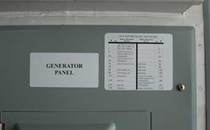
ncgenerators.com
Entire Structure Load or Just the Necessities?
Entire Structure Load or Just the Necessities?
There are four methods which can be used when installing a back up generator system.
- Entire structure (normal structure functions, no inconveniences)
- Entire structure managed (normal structure functions, maybe some inconvenience
- Isolation method (only basic necessity type loads)
- Isolation method managed (basic necessity items with additional loads to eliminate some inconvenience, used primarily on larger structure)
For systems providing backup for the entire structure, the National Electrical Code requires that a load calculation is performed and the selected generator system must be large enough to handle the potential load attachment to the system. This new law began in 2008 and covers optional standby as well as legally required systems.
The calculation is fairly simple and the results will give you the KW size of the structure load however it does not take into account inductive or capacitive load. Consideration for the type of load is necessary in determing the correct size generator, for affording you generator back up, with little or no inconvenience, for what may be long durations.
The isolation method will minimize the generator size for budget concerns, and typically only basic necessity type circuits are selected. There is no standard list or rule for circuit selection for an isolation method style installation and it usually is different for everyone however the refrigerator, microwave, gas furnace, well pumps, and hot water heater are typical . For the circuits which are chosen it is important the loads are calculated and the generator sized accordingly. Additionally the installing company should understand the mechanics of not only the transfer switch but also the branch circuitry of a structure so that there can be no back feed of generator power back to the utility lines.
The most common method used today is the entire structure managed. This typically will provide the biggest bang for the buck due to the system affording the entire structure generator back up power without covering the calculated load. This is allowed by electrical codes and is safe as long as there is automatic load management logic associated with the generator system. Most all manufacturers provide this logic with the generator systems. The logic monitors the attached load during a generator event and if it determines, per the parameters of the programming, that there is too much load, it will begin to shed certain heavier loads until it is satisfied there will be no overload for the generator. The most common loads managed, would be heating and air, electrical cooking appliances, and dryers. Priorities for each would be calibrated into the system and they would shed or reconnect per these priority levels if an overload did occur.


